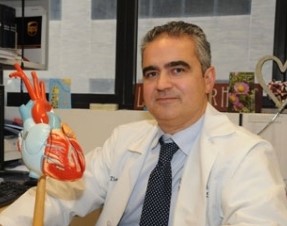
by targetmarket | Sep 15, 2023 | Dr. Giovanni B Ciuffo, Minimally Invasive Heart Surgeons, Minimally Invasive Heart Surgery, Uncategorized
Cardiovascular disease remains a leading cause of mortality worldwide. In fact, The American Heart Association (AHA) reports that approximately 82.6 million people in the United States currently have one or more forms of cardiovascular disease (CVD). Due to the prevalence of cardiovascular disease, there are continuous advancements in cardiac surgery techniques. Among these innovations, minimally invasive cardiac surgery stands out as a game-changer, offering numerous benefits over traditional open-heart surgery. Minimally Invasive Cardiac Surgery Minimally invasive cardiac surgery is an innovative approach that involves smaller incisions and advanced technology, resulting in shorter recovery times and improved patient outcomes. Dr. Ciuffo is an expert in high-risk heart surgery cases. He can evaluate your case and handle risk factors with our minimally invasive techniques with excellent results. Continue reading to learn 8 benefits of minimally invasive cardiac surgery. 1. Smaller Incisions And Reduced Scarring One of the most apparent benefits of minimally invasive cardiac surgery is the significantly smaller incisions made during the procedure. Compared to the large incision required for open-heart surgery, minimally invasive techniques use small keyhole incisions. As a result, patients experience less scarring, which not only has cosmetic benefits but also contributes to faster healing. 2. Quicker Recovery Time A shorter recovery time is a pivotal advantage of minimally invasive cardiac surgery. Patients typically spend less time in the hospital after the procedure and can return to their daily activities sooner. This reduced recovery period can lead to a higher quality of life and less disruption to the patient’s routine. 3. Reduced Pain and Discomfort Minimally invasive procedures are associated with less postoperative pain and discomfort.... 
by DrCiuffo | Oct 15, 2022 | Blog, Heart Surgery, Minimally Invasive Heart Surgery
3 Advantages of Minimally Invasive Heart Surgery New technologies are emerging all the time. As open heart surgery treatments advance, there are new options and choices facing patients. As you move toward open heart surgery as a treatment, consider all your options and weigh the benefits and risks with your medical team to decide the best course of action. With a doctor you can trust, like Dr. Ciuffo, you can start to understand the procedures more than before and not worry about making the right decision. Our team is here for you every step of the process. Open Heart Surgery It used to be that open heart surgery was a last-resort risk. The recovery time was slow, and the procedure often left behind large scars which took a long time to heal. To reach the heart, traditional open heart surgery involves breaking through the ribcage, usually through the sternum itself. This left the patient with a long, hard, and often painful recovery. New techniques and technologies allow for a much less invasive option for most patients. Sternotomy Traditionally, open heart surgery, or sternotomy, meant entering the chest through a large incision, breaking the sternum to reach the heart, and performing the surgery. The potential problems included inflammation, swelling, pain, a longer recovery, and infection. The shock to the heart and the blood loss made it more difficult for patients to recover fully and heal efficiently. Fortunately, minimally invasive heart surgery options are now available. Minimally Invasive Heart Surgery With minimally invasive heart surgery, there is a much smaller incision, which can often be hidden beneath the fold of a... by DrCiuffo | Feb 5, 2020 | Articles, Blog, Dr. Giovanni B Ciuffo, Heart Health, Heart Surgery, Minimally Invasive Heart Surgeons, Minimally Invasive Heart Surgery, Uncategorized
What is a Pulse Deficit? The concept of a pulse deficit can be both confusing and frightening if you’re not a member of the medical community, but it has a direct bearing on the health of your heart and can be life threatening if not treated properly and allowed to get worse. It sounds confusing, but is quite simple. When your heart beats, it sends blood through the arteries of your body. This produces a noticeable pulse which can be felt. Normally these two events are in synch, but it is when they are not in synch, the pulse and the beat of your heart, that problems can arise. What Causes a Pulse Deficit? There are several causes for a pulse deficit, some of which are not necessarily indicators of heart disease, such as heavy exercise. Other causes of a pulse deficit are not so innocent, however, and can include low blood pressure, periods of extreme anxiety or stress, extended periods of chronic pain, and bodily injury or trauma, including blood loss. What happens when there is a pulse deficit is that when the heart beats, but there is no pulse of blood that comes after. This creates a pulse deficit. How is it Treated? Observing that someone has a pulse deficit is fairly straightforward. A doctor or nurse listens to your chest with a stethoscope and notes the heartbeat, but when they attempt to take your pulse, do not notice the same number of pulse beats. The symptoms of pulse deficit include a noticeably decreased resting heart rate and a long-term consistent history of having a different resting... by DrCiuffo | Jan 30, 2020 | Articles, Blog, Dr. Giovanni B Ciuffo, Heart Health, Heart Surgery, Minimally Invasive Heart Surgeons, Minimally Invasive Heart Surgery, Uncategorized
LIMA LAD is a life-saving procedure for your heart. What LIMA LAD does is open your heart’s blood flow by involving two different arterys. These are the left internal mammary artery and the left anterior descending artery, or LIMA LAD for short. This minimally invasive procedure results in a tiny scar that hides under the fold in your breast. What Do The LIMA LAD Organs Do? Your LAD is meant for being able to carry your blood around the heart. It does this by traveling between your right ventricle at the front of your heart and the left as well. When blocked, blood can’t make its way to its appropriate destination. When this happens, it means your heart struggles as well. The LIMA, on the other hand, is on the heart’s left side. When blockages settle in the vessels around your heart due to heart disease, it puts a strain on your heart. That, in turn, will keep your heart from pumping the way that it should. When you can receive a heart surgery that is both bloodless and invasive on a minimal level, it will create a new route for your blood to flow. A catheter will be placed into the area of the blockage, and it has a balloon tip. The balloon is inflated to stretch the vessel gently. When it does this, it will release the blockage. What Benefit Do We Receive from a Minimally Invasive Surgery? When you have minimally invasive surgery, particularly a bloodless one, the procedure is low impact and one of the best options. With these new techniques being adopted, the... by DrCiuffo | Sep 4, 2019 | Coronary Surgery, Articles, Blog, Dr. Giovanni B Ciuffo, Heart Health, Heart Surgery, Minimally Invasive Heart Surgeons, Minimally Invasive Heart Surgery, Recovery, Uncategorized
Heart surgery is one of the most sophisticated and complex types of surgery. It is demanding and requires an excellent team of physicians, assistants, and support personnel. Minimally invasive heart surgery significantly decreases the amount of trauma and damage to the patient and makes for a much easier recovery. What is Bloodless Heart Surgery? Related to advances in heart surgery, bloodless surgery has made great strides since the 1990s. Instead of using transfusions to replace blood lost during surgery, great efforts are made to reduce bleeding during surgery and harmonic scalpels clot blood while cutting tissue. Hemostatics stop bleeding before, during, and after surgery. Bleeding vessels can be sealed by an argon beam coagulator. Also, what blood is lost during the procedure is collected and returned to the patient’s circulatory system. Bloodless surgery avoids complications of transfusion, including disease (negligible risk), depression of immune system function, allergic reaction to additives in stored blood, and inflammatory response. Avoiding transfusions can make for a better recovery after heart surgery. Combining minimal blood loss with minimally invasive heart surgery can give excellent results for recovery, even with elderly or frail patients, who would have been a poor risk with earlier kinds of techniques. Still, the doctor’s skill and experience are important factors in how well the surgery, and the recovery, go. Does This Surgery Cause Scarring? Usually, minimally invasive heart surgery is done with a two-inch incision between the ribs. So, unlike earlier versions of heart surgery, bones do not have to be broken to gain access to the heart. Given time after surgery, the scar can fade to where it is... by DrCiuffo | Mar 15, 2019 | Coronary Surgery, Articles, Blog, Dr. Giovanni B Ciuffo, Heart Health, Heart Surgery, Minimally Invasive Heart Surgeons, Minimally Invasive Heart Surgery, Uncategorized
Minimally invasive heart surgeons perform procedures that cause less trauma and pain, resulting in quicker recovery times compared to open-heart surgery. These surgeons perform procedures using small incisions in your chest as a safer alternative to open-heart surgery. Rather than having to cut through your breastbone, minimally invasive heart surgeon qualifications allow them to operate between the ribs, resulting in less pain and faster recovery time. In fact, surgeons sometimes have a better view of certain areas of the heart than with open-heart surgery. The vast majority of minimally invasive procedures don’t require the surgeon to stop your heart. How do I know if I’m a good candidate for a minimally invasive heart procedure? Depending on various personal factors, minimally invasive surgery might be the perfect option for you. Other benefits may include: Lower risk of infections Less blood loss Reduced pain and trauma Shorter hospital or clinic stay Smaller and less noticeable scars It’s also very important that your minimally invasive surgeon strives for cohesion and clear, open communication within his team. It’s vital that the team knows your specific needs and whether or not minimally invasive surgery is for you. In addition, you want your heart specialists to exhibit those same characteristics with all your other healthcare providers. Other Preparation? Make sure you’ve had a recent physical examination, with a complete review of your medical history and blood analysis. There is a chance you may have to get your procedure done at a medical center. This decision is based on your physicians’ and specialists’ evaluation of your condition. What kind of minimally invasive heart procedures are available?...



